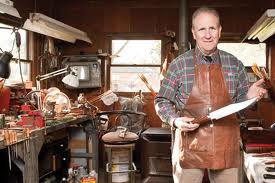Jim Bowie, born in Logan
County, Kentucky in 1796, was a sturdy fellow, 6 feet tall and weighing 180
pounds. His reputation as a womanizer was equaled only by his reputation as an
inveterate fighter. The story of his heroic death at Fort Alamo on the 6th
of March 1836 alongside Davey Crockett is one of the great stories of bravery
in American legend. His courage and skill with a knife made him one of the top
experts in such weapons: from there it was but a short step to designing new
forms of blades.
In the course of the
year 1830 he developed a completely original design, the wooden model of which
he gave to James Black, a renowned blade smith of Washington, Arkansas,
requesting that the knife be produced within nineteen days. Black scrupulously
respected all of the details, but holding his client in high esteem and
considering that the proposed design had certain flaws, he made a second
version according to his own design. Even forging the blade from a meteorite
that he had been saving for such an exceptional occasion. When Jim came to
collect his knife he was presented with the two models and asked to choose
which one he wanted, for no additional cost. He chose the second one, it was
this vey same knife that he was carrying at the Alamo, and which disappeared
with him in the ensuing battle.
A “Bowie” is a straight
knife, with a particularly long and powerful blade that also has a most
characteristic shape, particularly the part where the reverse edge curves up.
“Bowie” became synonymous with large blade knives and this genre is
particularly sought after in the United States even today, but opinions differ
considerably concerning the characteristics of the original model. At the time
it was common to carry a large straight knife at one’s belt, and Jim Bowie was
certainly no exception, never missing an opportunity to “clash swords”. He is
credited with a fair number of fights and even duals, the most famous of which
took place on the 19th of September 1827 at Avoyelles Rapides
Parishes, Louisiana. (This is an historical fact).
A number of writings
belonging to Jim’s brother Rezin were conserved in a museum. In one of them he
mentions that: “The first Bowie knife was made by myself in Avoyelles Parish;
it was intended only for hunting and I carried it for several years; the blade
was 23 centimeters long a 4 wide, with a single cutting edge and not curved.
Rezin then added several
modifications and improvements before getting a number of knives made by a
local smith. Apparently it was one of these knives that Jim used for his most
famous duel, as well as another on against a certain Sturdivant, who was only
wounded and vowed revenge, sending three desperadoes after him some years later
who, literally lost their heads to the powerful weapon forged by Black. Rezin
also designed another model after an unfortunate encounter with a bull that
charged him when he was riding nearby. He drew his knife to defend himself but
the shock when he stabbed the bull caused his fingers to slip over the
inadequate guard and onto the blade. Following this incident, he decided to
lengthen the blade, give it a reverse-edge and a wraparound guard for better
protection, just like a sable.
We will probably never
truly know what this famous knife, about which so much has been written, really
looked like. There are a great many collectors of the genre in the United
States. Naturally, each one claims to hold either the most authentic model or
at least the one most resembling that of their hero. But there are so many
differences in shape, style and size that one can easily get confused.
Perhaps we should just
content ourselves to let out imagination run free, as do so many of Uncle Sam’s
nephews.




